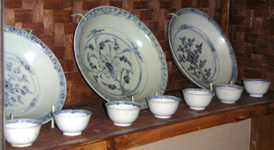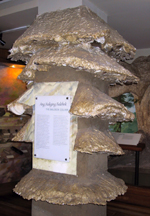The Origin (Pinagmulan)
3rd floor, South Wing Gallery
The gallery presents information on the origins of the Philippine Islands and the Filipino nation. The exhibition focuses on the four periods of Philippine pre-history : Paleolithic; Neolithic; Metal; and Ceramic Age.

The Philippine archipelago was formed about 70 million years ago, the result of million of years of volcanic and tectonic activities. The continents of the world sit on shifting plates. Pressures from inside the earth pushed various plates against one another that reshaped the land and led to the formation of new landmass, mountain chains, volcanoes and sometimes the emergence or disappearance of islands.
During the last 2 to 3 million years the ancestors of humans evolved in Africa and Asia and spread to other parts of the world. The earliest evidences of the presence of people in the Philippines can be dated to 750,000 years ago, during the Pleistocene epoch. This came in the form of stone tools and fossils of large migrating animals such as elephas, stegodons, rhinoceros, and giant turtles found in Palawan and Cagayan Valley. This discovery provides valuable information about ancient humans in the Philippines, their environment and strategies for survival. Humans led a mobile existence, hunting and gathering, living in caves, and using fire and stone tools.

Archaeological evidences of the Neolithic Period showed that life ways of the people had changed a great deal from earlier times. It was clear that humans were paying more attention to the shape of the stone tools. From archaeological sites now began appearing polished stone tools primarily blade-like tools, stone adze, shell adze and red slipped pottery. If before humans only gathered food from nature, now they learned how to domesticate plants and animals. However, hunting and gathering was still a successful form of subsistence during the Neolithic.
Another great change took place in the islands as shown in the materials that were found from archaeological sites. By this time, the use of metals had already become widespread. The earliest metals to appear were gold, copper and bronze, in the form of ornamental beads and tools like adzes and spearheads. This period is known not only for the appearance of metals, but also as the Golden Age of Pottery. While the pieces produced in the previous age were indeed beautiful, pottery from the Metal Age is characterized by exquisite and intricate patterns and designs reflecting complex societies. Among the highlights of the Metal Age Pottery are burial jars which indicate the burial custom practiced by the ancient people of the period.
A new change took place in the Philippines about 1000 A.D. From the archaeological sites, the age is distinguished by the appearance of high-fired ceramics. This gave proof to the increased maritime trade and cultural contact between the Philippines and her Southeast Asian neighbors. The quantity of Asian trade materials appears to be greater in the southern parts of the country. Underwater archaeological evidences indicate the existence of trade routes that brought the products of the Spice Islands (the Moluccas) up from the South, and the luxuriously manufactured items of China mainland, especially silk and porcelain, directly to Filipino harbors.


